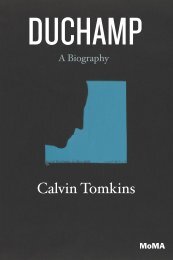Still Life in Watercolors
qbj8dgc
qbj8dgc
- No tags were found...
You also want an ePaper? Increase the reach of your titles
YUMPU automatically turns print PDFs into web optimized ePapers that Google loves.
Figure 45 ><br />
St/7/ <strong>Life</strong> with Blue Pot (pl.i)<br />
with blues separated out<br />
thicken<strong>in</strong>g <strong>in</strong>to translucency, <strong>in</strong>stead of the<br />
reverse. It signposts the sta<strong>in</strong> of rose that<br />
spreads onto the upper arc of the handle and<br />
the fa<strong>in</strong>t, crisscross<strong>in</strong>g l<strong>in</strong>es of graphite<br />
that emerge from beneath it and trail onto<br />
the downward trend of the outer part of the<br />
handle. And it competes with the thick<br />
black l<strong>in</strong>e that Cezanne applied, also toward<br />
the end, to re<strong>in</strong>force the <strong>in</strong>ner contour<br />
of the open<strong>in</strong>g made by the pitcher's handle.<br />
Cezanne could have stopped before add<strong>in</strong>g<br />
that touch of green, but he did not. He could<br />
have added further touches of green here<br />
and there after the one that drifts from the<br />
body to the handle of the pitcher, but he<br />
didn't. He stopped just there; he must have<br />
felt that it was just right, or as close to it as<br />
he was go<strong>in</strong>g to get.<br />
Inspired by Cezanne filtered through<br />
Chard <strong>in</strong>, Rilke remarked that he wanted<br />
to write a "history of blue. " l And others remarked<br />
on the blue draw<strong>in</strong>g that is found<br />
everywhere <strong>in</strong> the composition, re<strong>in</strong>forc<strong>in</strong>g<br />
the contours of the objects at the center,<br />
overlay<strong>in</strong>g their underly<strong>in</strong>g graphite with<br />
Prussian blue, as if to br<strong>in</strong>g the underdraw<strong>in</strong>g<br />
to the surface (fig. 45). When he saw the<br />
show atAmbroise Vollard's gallery <strong>in</strong> 1905,<br />
Maurice Denis remarked that the watercolors<br />
were "built out of vibrant contrasts on preparatory<br />
washes of Prussian blue; the def<strong>in</strong>itive<br />
color of these sketches, as composed<br />
and constructed as pictures, has been raised<br />
to a powerful and admirable resonance. One<br />
would have said they were ancient faiences." 2<br />
Denis might have added that the blue also lay<br />
over both the "preparatory washes" and the<br />
"vibrant contrasts" as a f<strong>in</strong>aliz<strong>in</strong>g, re<strong>in</strong>forc<strong>in</strong>g<br />
armature, a k<strong>in</strong>d of bright exoskeleton,<br />
draw<strong>in</strong>g made of color on top of color upon<br />
color, on top of draw<strong>in</strong>g made of graphite.<br />
But he did understand the importance of<br />
blue—it provided the keynote and, <strong>in</strong> this<br />
particular watercolor, the central blue object.<br />
Denis also saw that these "sketches" were<br />
"pictures"—none more so than this one—<br />
and like others he felt that there was someth<strong>in</strong>g<br />
ceramic (and Provencal) about them—<br />
aga<strong>in</strong>, none more than <strong>Still</strong> <strong>Life</strong> with Blue<br />
Pot, with its overall Provencal palette and its<br />
porcela<strong>in</strong> pitcher, made of white paper,<br />
blue marks, h<strong>in</strong>ts of rose, touch of green, and<br />
re<strong>in</strong>forc<strong>in</strong>g black and blue.<br />
Andre Fonta<strong>in</strong>as, for one, spoke of the<br />
effect of "pa<strong>in</strong>tedporcela<strong>in</strong>"produced by the<br />
watercolors. He too spoke of the overlay<br />
of colors: "The master amuses himself. But his<br />
diversions are wondrous marvels and beautifully<br />
<strong>in</strong>structive. They make play with bold<br />
blues, pure whites, clear yellows ... and<br />
they sometimes give the illusion of pa<strong>in</strong>ted<br />
porcela<strong>in</strong>, of delicate, iridescent opals.<br />
Others, with only a few touches of color, are<br />
admirable draw<strong>in</strong>gs. " 3 Po<strong>in</strong>t<strong>in</strong>g to the oscillation<br />
between draw<strong>in</strong>g and color, the bare<br />
m<strong>in</strong>imum and the spectacular deployment of<br />
brilliant primary colors, with "bold blues"<br />
lead<strong>in</strong>g the way, Fonta<strong>in</strong>as obviously delighted<br />
<strong>in</strong> the lightness of the watercolors and nevertheless<br />
took them seriously; he found them<br />
"<strong>in</strong>structive." In 7907 Rilke loved the lightness<br />
of the watercolors too; he wrote <strong>in</strong> a letter<br />
that he had seen the show at Bernheim-Jeune<br />
and had found the watercolors "extremely<br />
beautiful. They are just as assured as the<br />
pa<strong>in</strong>t<strong>in</strong>gs, and as <strong>in</strong>substantial as the pa<strong>in</strong>t<strong>in</strong>gs<br />
are solid.... Very fa<strong>in</strong>t pencil outl<strong>in</strong>es,<br />
upon which only here and there, almost as<br />
emphasis and confirmation, an accidental bit<br />
of color falls, a row of spots of pigments<br />
wonderfully arranged and as sure <strong>in</strong> their<br />
touch as if they were reflect<strong>in</strong>g a melody." 4<br />
Perhaps that green touch on the white pitcher<br />
<strong>in</strong> <strong>Still</strong> <strong>Life</strong> with Blue Pot was one of those<br />
f<strong>in</strong>al "accidental bit[s] of color" that became<br />
an "emphasis" and a "confirmation."<br />
Others, such as Robert Delaunay, saw<br />
the "colored planes" of the watercolors as<br />
the "precursor... of Cubism." 5 But though all<br />
those that loved the watercolors clearly took<br />
them seriously, perhaps more seriously than<br />
Cezanne himself <strong>in</strong>tended them, they tended<br />
to emphasize, not their avant-gardism, but<br />
their delicacy, their airy <strong>in</strong>substantiality, their<br />
play with process. 6 Indeed, it was Cezanne's<br />
young admirer Emile Bernard, most immediately<br />
responsible for craft<strong>in</strong>g Cezanne's<br />
mythic status as the old man of modernism,<br />
who described his watercolor process, hav<strong>in</strong>g<br />
seen him execute a landscape <strong>in</strong> the medium:<br />
"His method was remarkable, totally different<br />
from traditional procedures and extremely<br />
complicated. He began with a s<strong>in</strong>gle patch,<br />
which he then overlapped with a second, and<br />
a third, until these patches, which produced<br />
screens, modeled the object by means of<br />
color." 7 Accord<strong>in</strong>g to Bernard, Cezanne<br />
began with "a patch": did he also end with a<br />
patch—of a different color than the one with<br />
which he began? It seems likely—though<br />
where the graphite draw<strong>in</strong>g fits <strong>in</strong> is uncerta<strong>in</strong><br />
<strong>in</strong> this account. And what significance a<br />
green had <strong>in</strong> relation to all the blue—this<br />
time a milligram <strong>in</strong>stead of a kilo of green—<br />
well, that is for us to determ<strong>in</strong>e.<br />
This watercolor, of course, is a still life,<br />
not a landscape, and so its air of "faience"<br />
i 3 8<br />
CEZANNE IN THE STUDIO




